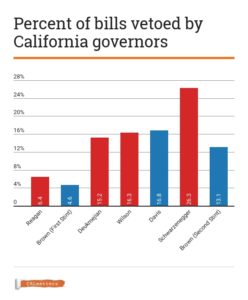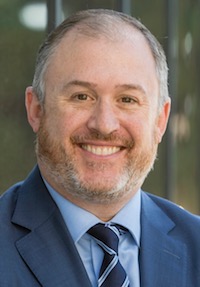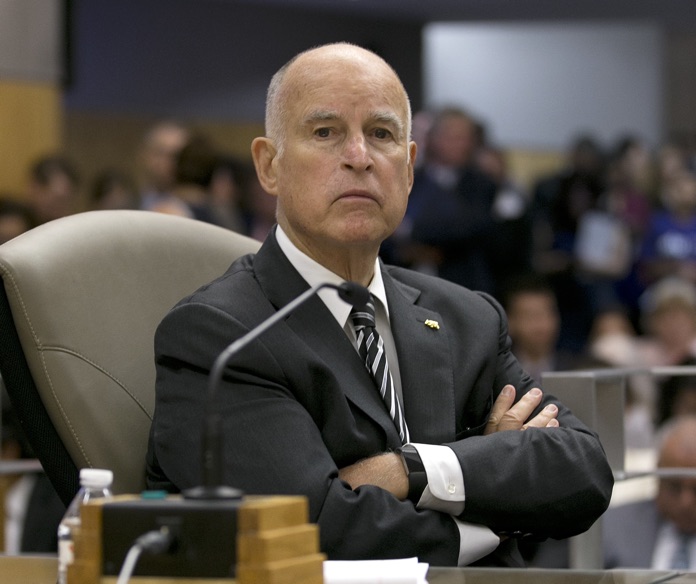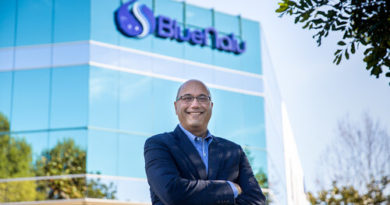Daily Business Report-Oct. 19, 2017
Gov. Jerry Brown (Photo by Rich Pedroncelli, Associated Press)
Revealing Rejections: Jerry Brown’s
Vetoes Are a Window into his Mind
By Laurel Rosenhall | CALmatters
Gov. Jerry Brown is famously enigmatic, a difficult-to-predict politician who said decades ago that he likes to “paddle a little bit on the left side, then… a little bit on the right.”
But every year Brown drops clues to his governing approach in a raft of letters he writes to the Legislature detailing why he’s vetoed certain bills. Veto messages are required by state law; most of Brown’s are simple notes of about five or six sentences, straight and to the point.
Sometimes, though, Brown expounds with an obscure historical reference or an impassioned philosophical argument. He referenced the legal systems of ancient Rome and 17th century England in a three-page-long veto message in 2013, and, in a 2014 veto message, instructed lawmakers to read a 50-year-old essay in the Federal Bar Journal.Together, the veto messages provide a window into the mind of California’s longest-serving governor.

Though Brown doesn’t veto many bills — about 13 percent since he returned to the governor’s office in 2011 — his vetoes express a consistent set of themes about how government should function. He writes many of the messages himself, frequently by dictating to a staff member. And when he edits one written by an aide, he weighs in on everything from “the literary to the substantive to the grammatical,” said his executive secretary, Nancy McFadden.
This year Brown, a Democrat, signed 859 bills and vetoed 118. Here’s what his vetoes reveal: Every now and then, Brown puts the brakes on big government. Having signed nearly 17,000 bills into law during his four terms as governor, Brown is no libertarian. Yet he sometimes sees a limit to how many rules we need. “If people can’t smoke even on a deserted beach, where can they? There must be some limit to the coercive power of government,” Brown wrote in rejecting two bills that would have banned the practice. He also vetoed a bill that would have put new restrictions on drivers age 18 to 21, writing that it would “create a burden on a segment of adult Californians that are no longer seen as a minor in the eyes of the law.”
Brown biographer Chuck McFadden (no relation to Nancy McFadden) said the governor has long displayed a “curious, almost Republican strain of keeping government out of people’s business.”
Brown is cautious about “resisting” President Trump. Democratic legislators spent much of 2017 railing against the new Republican president, and passed several bills aimed at tweaking or thwarting his administration. Brown signed some of them, including a scaled-back version of the “sanctuary” bill to shield some undocumented immigrants, but rebuffed others. “While I recognize the political attractiveness — even the merits — of getting President Trump’s tax returns, I worry about the political perils of individual states seeking to regulate presidential elections,” he wrote in vetoing a bill that would require presidential candidates to release their taxes in order to be placed on a California ballot. “I am not prepared to codify additional requirements in reaction to a shifting federal landscape,” Brown penned in vetoing a bill to incorporate Obama-era regulations on college campus sexual harassment into state law.
The governor also jettisoned a bill that would require the state to preserve scientific data the Trump Administration might try to destroy. Brown said he would simply tell his administration to save the data. Brown doesn’t often change his mind. If Brown vetoed a bill before, he will likely veto it again. And he’s quick to remind lawmakers that he gets the last word. Several veto messages this year included phrases like: “After twice vetoing prior attempts…” (vetoing a bill regarding wages for workers contracted by the University of California.) “As I stated in 2014 when I vetoed a nearly identical bill…” (vetoing a measureto require a California trade office in Mexico City.) “I vetoed a similar bill in 2015…” (vetoing a bill to impound cars after a driver’s second case of reckless driving.)
Brown does sign some bills he’s vetoed in the past — but usually only if lawmakers have made some changes to it. Brown doesn’t like to enact a law that should be a budget item.
That was his argument for vetoing bills to provide grants to rescue marine mammals and sea turtles, to educate Californians about Valley Fever, and to expand programs for disabled adults. In vetoing a pair of bills that would create new tax breaks, Brown wrote: “These bills are an end run of the budget process.” He went on to say that the negotiation-filled budget process “is the best way to evaluate and prioritize all new spending proposals, including those that create new tax breaks.”
Lobbyist Chris Micheli, an expert in tax law, said this governor has been more of a stickler than past governors in vetoing tax exemptions: “He wants them done as part of the budget and not stand-alone.” Brown is wary of creating new crimes and punishments. Two years ago Brown vetoed a slew of measures that would have created new crimes — saying that California’s criminal code had already grown to “more than 5,000 separate provisions, covering almost every conceivable form of human misbehavior.” “This multiplication and particularization of criminal behavior creates increasing complexity without commensurate benefit,” Brown wrote in 2015.This year he put the kibosh on bills that would have added a $1,000 penalty for assaultinga public utility worker and for taking a photo of someone without their consent and distributing it. And that bill creating a new misdemeanor for false or misleading advertisements related to the sale of cats and dogs? Also a no.
CALmatters.org is a nonprofit, nonpartisan media venture explaining California policies and politics.
____________________

First Product from USD’s
Donald’s Garage Hits the Market
A slider system for consumers to take professional quality time-lapse and tracking shots with their smartphones and GoPro cameras is the first product from Donald’s Garage at the University of San Diego Shiley-Marcos School of Engineering.
Commercial camera slider systems can cost thousands of dollars and are cumbersome to carry in the wild. But Trek, initially conceived and developed by engineering students as a senior design project, can be carried in a backpack.
“Today’s smartphone and GoPro cameras can fit in the palm of your hand but the accessory industry hasn’t kept up with the revolution,” said Chris Szczur, co-founder of Dyno Equipment. “Trek is the answer to that gap in the marketplace.”
Using magnetized tracks, Trek works much like a model train or Hot Wheels set that can be taken apart and assembled in just a few minutes.
“Whether you’re snowboarding in the Sierras or hiking in the Himalayas, you can carry Trek with you to take incredible photos and shots of your adventure,” said Scott Matthews, Dyno Equipment’s other co-founder.
To see Trek in action and pre-order the system, starting at $199, go to https://igg.me/at/dynotrek.
Following graduation from USD in 2016, Matthews and Szczur continued to work on the project in Donald’s Garage. The facility was part of Darlene Marcos Shiley’s gift to USD to encourage entrepreneurs to follow in the footsteps of her late husband, Donald Shiley, who developed a revolutionary heart valve in his garage.
“This project exemplifies the ‘maker philosophy’ we want to instill in our students to become innovators and entrepreneurs,” said Chell Roberts, Dean of the Shiley-Marcos School of Engineering.
“We really appreciate the great support we’ve received from USD,” Szczur said. Both Professor of Practice and Director of Industry Partnerships Venkat Shastri and Assistant Professor of Mechanical Engineering Daniel Codd, worked with them, along with Steven Saxer and Sam Burt in the school’s Machine Shop.
The USD School of Law’s Entrepreneurship Clinic also assisted the pair, and Clarity Design, one of the engineering school’s industry partners, is providing support to design and manufacture Trek.
“It’s really exciting to see Scott and Chris’s project come to market and we look forward to their great success,” said Professor Codd.
The Shiley-Marcos School of Engineering at USD is ranked 12th in the nation for schools whose highest degree is a bachelor’s or master’s by U.S. News & World Report.
____________________

SENTRE Starts Construction on New
Multi-Family Property in La Mesa

San Diego-based commercial real estate investment firm SENTRE has announced plans to develop a new apartment community, Villea at Lake Murray, a modern living experience rooted in classic California style.
As the newest development in the Lake Murray neighborhood of La Mesa, Villea is slated to open its doors to residents in fall 2018.
Located at 5565 Lake Murray Blvd., Villea will feature 27 townhomes for rent, each averaging more than 1,000 square feet. Each new home at Villea will feature attached garages, quartz countertops, stainless steel appliances, hardwood flooring, central heat and air and in-unit washers and dryers. Onsite amenities will include a clubhouse and lifestyle center, fitness center, spa, BBQ station, secured parking and community-wide wireless Internet. Rental rates are expected to start near $2,500 per month for a 2-bed, 2.5 bath townhome with attached 2-car garage.
____________________
Cubic’s GATR Technologies Awarded
Contract to Support New Zealand Defence Force
Cubic Corporation announced that GATR Technologies, a subsidiary, was awarded an order worth more than $5 million to provide satellite communication systems for the New Zealand Defence Force (NZDF). Cubic will supply 2.4-meter inflatable satellite antennas with supporting hardware, spares and New Equipment Training for the NZDF Network Enabled Army (NEA) program. In addition to a multi-year support contract,
“GATR’s SATCOM is expected to provide the New Zealand Army with a communications solution that meets its tactical requirements and enhance the command and control capabilities of its forces when deployed on operations. Work is expected to commence soon to integrate GATR into the New Zealand Defence Information Environment,” said Major General Peter Kelly, New Zealand Chief of Army.
____________________
La Jolla Shores Boardwalk Named
After Legendary Oceanographer
The city of San Diego recognized science icon Walter Munk on the eve of his 100th birthday by officially naming the La Jolla Shores boardwalk in his honor and proclaiming Oct. 19 to be “Walter Munk Day.”
Three honorary “Walter Munk Way” street signs were installed along the length of the boardwalk (La Vereda Street). Officials from the city, county, state, and the University of California San Diego participated in a ceremony unveiling the honorary “Walter Munk Way” street signs at Kellogg Park in La Jolla Shores.
Walter Munk joined Scripps Institution of Oceanography as a young doctoral student in 1939 in what would start nearly eight decades of scientific discovery, daring science, and transformation of how the world understands the ocean. Scripps Oceanography became part of the University of California San Diego in 1960, making Munk the oldest living UC San Diego alumnus.
Often called the “Einstein of the Oceans,” Munk is known for inventing the science of wave forecasting along with Scripps Director Harald Sverdrup, which helped Allied troops plan amphibious invasions during World War II. Munk also pioneered tide prediction and many aspects of ocean acoustics, ocean circulation, and deep-sea tides. In recent years, Munk has met with His Holiness the 14th Dalai Lama and Pope Francis as a scientific advisor speaking on the urgency to act on climate change. Known for his never-ending curiosity, Munk still conducts research today.
Munk reflected on the honor bestowed upon him by saying, “I am so very pleased because it connects Scripps’ work to the community that has been my home since 1939.”
____________________
Personnel Announcements
Derek Danziger Joins Katz & Associates as President

Katz & Associates announced the appointment of Derek Danziger to the role of president effective Nov.6. He will be responsible for oversight and strategic direction for the firm’s three offices and 40 employees. He will report directly to founder and CEO Sara Katz.
Danziger has more than 20 years of strategic public relations, marketing and communications experience, primarily in the public sector. He most recently served as a vice president at Nuffer, Smith, Tucker, where he successfully developed the firm’s Public Outreach and Community Relations practice. Prior to his work with NST, Danziger served as vice president of marketing and communications for the former Centre City Development Corporation, media center director for LEGOLAND California, director of media and public relations for the Super Bowl XXXII Host Committee, and a manager in SeaWorld San Diego’s education department. He is currently a board member on the San Diego Regional Chamber of Commerce and an alum of LEAD San Diego. Danziger is a graduate of UC San Diego and past president of the San Diego/Imperial Counties chapter of the Public Relations Society of America.




